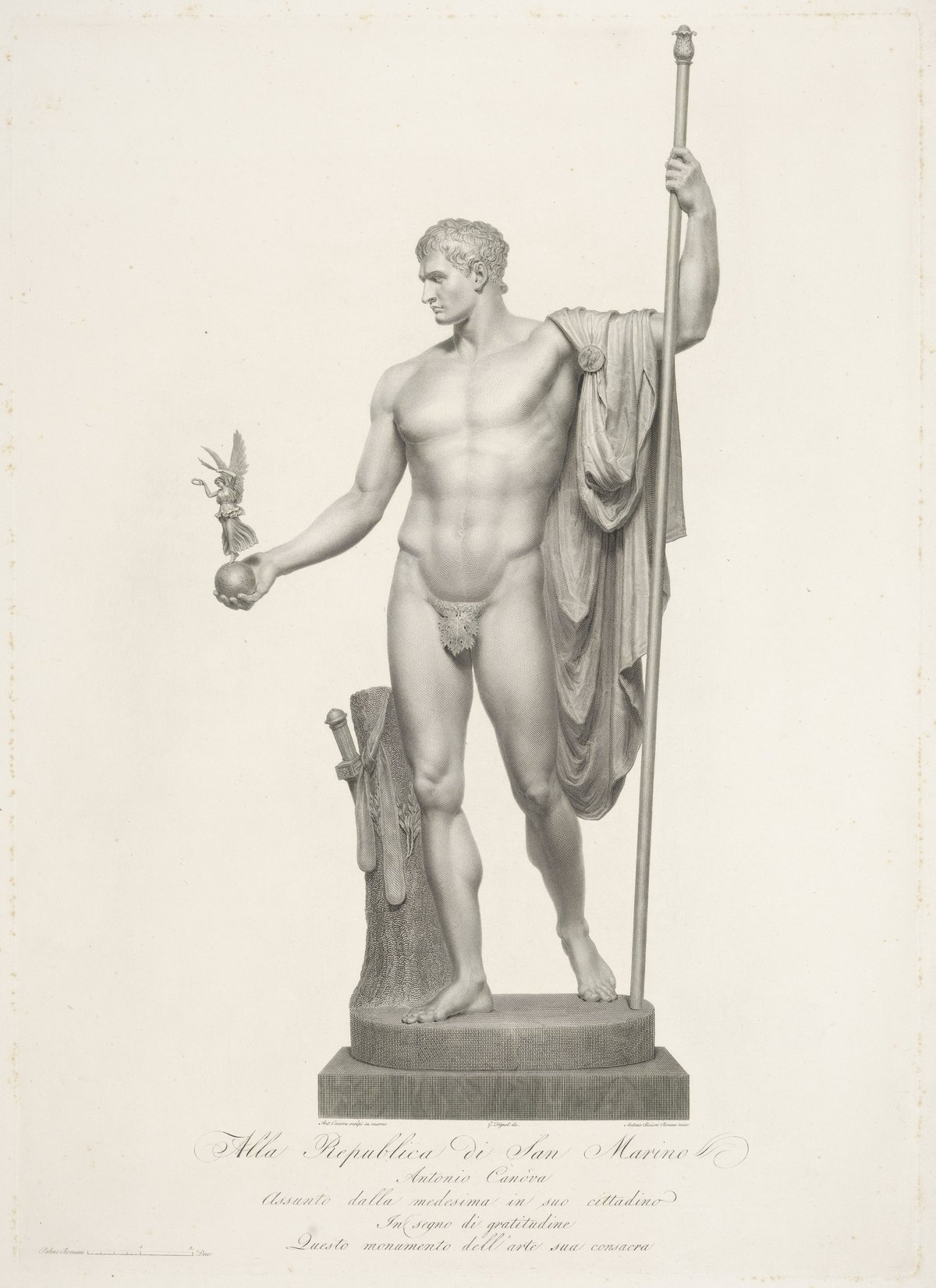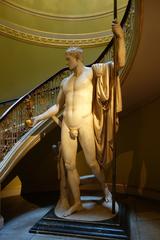
Napoleon as Mars the Peacemaker at Apsley House, London: Tickets, Visiting Hours & Historical Guide
Date: 15/06/2025
Introduction
Antonio Canova’s Napoleon as Mars the Peacemaker is a remarkable neoclassical sculpture that powerfully embodies both the ambition and contradictions of its era. Commissioned by Napoleon Bonaparte in 1802 and completed in 1806, the statue depicts the French leader as a classical hero, not only as a conqueror but as a bringer of peace. Today, this monumental marble work occupies a central place at Apsley House—once the home of Arthur Wellesley, 1st Duke of Wellington, Napoleon’s famed adversary. The statue serves as both a testament to artistic genius and a symbol of shifting European power, making Apsley House a must-visit for lovers of art, history, and culture (Victorian Web, English Heritage, Art Facts).
This guide explores the history, symbolism, and visitor experience of Napoleon as Mars the Peacemaker, alongside up-to-date information on opening hours, ticketing, accessibility, and nearby attractions.
Table of Contents
Background & Artistic Significance
The Statue’s Commission and Creation
Antonio Canova, renowned for his mastery of neoclassical sculpture, was commissioned by Napoleon at the height of the latter’s power to create an enduring image of imperial authority. Initiated in 1802, the statue was completed in 1806 and stands over 3.4 meters high. Canova depicted Napoleon as Mars, the Roman god of war, but imbued with the attributes of a peacemaker: nude in the classical heroic tradition, with a globe surmounted by a gilded Victory in his right hand and a staff of rule in his left. Armor and sword, symbols of war, rest at his feet—emphasizing peace over conquest (Victorian Web).
Symbolism and Artistic Interpretation
Canova’s choice to render Napoleon as an idealized, godlike nude was deliberate, aligning his subject with ancient heroes and emperors. The statue’s pose and expression, however, introduce nuance: the stance is dynamic yet contemplative, and the averted gaze suggests both power and introspection. Art historians note that this ambiguity reflects conflicting views of Napoleon—both as a unifier and a conqueror. Canova himself, though admiring of Napoleon, was ambivalent given the French leader’s actions in Italy and the plundering of Italian art (Victorian Web).
Napoleon’s Response and the Statue’s Journey
Napoleon was ultimately dissatisfied with Canova’s work. The heroic nudity and idealized physique clashed with his preference for being depicted as a uniformed general; he reportedly found the statue embarrassing and had it stored out of public view. After Napoleon’s fall, the statue was sold to the British government and presented to the Duke of Wellington, who displayed it at Apsley House, not as a trophy but as a work of great art and complex history (Victorian Web).
Arrival at Apsley House
Apsley House, at the southeast corner of Hyde Park, became the statue’s new home in 1817. Wellington, himself an admirer of both Canova and Napoleon, showcased the sculpture prominently, surrounded by treasures and trophies of his military campaigns. The juxtaposition of Napoleon’s idealized form with Wellington’s historic residence offers a vivid commentary on the shifting fortunes of Europe’s great powers (English Heritage).
Legacy and Broader Context
The journey of Napoleon as Mars the Peacemaker—from imperial commission, to neglect, to pride of place in the house of Napoleon’s greatest rival—mirrors the tumultuous history of early 19th-century Europe. The statue influenced later depictions of leaders and remains a key artifact at the intersection of art and politics. Additional casts and busts based on Canova’s model can be found in European collections, attesting to the work’s enduring significance (Art Facts, thehistoryofart.org, everything.explained.today).
Visiting Apsley House
Hours, Tickets, and Access
- Address: 149 Piccadilly, Hyde Park Corner, London, W1J 7NT
- Opening Hours (as of June 2025):
- April 1 – December 23 & January 2 – March 28:
- Wednesday–Sunday, 11:00 am – 5:00 pm (last entry 4:30 pm)
- Closed December 24–26 and January 1
- April 1 – December 23 & January 2 – March 28:
- Ticket Prices:
- Adult: £12.50
- Concessions: £10.00
- Children under 16: Free
- Family and group rates available
- Joint ticket with Wellington Arch: £16.00
- English Heritage members: Free
- Purchase: Online advance booking is recommended, especially during peak seasons.
Guided Tours & Visitor Experience
- Guided tours and multilingual audio guides are available, offering deeper insight into the statue and the house’s collections.
- Interpretive panels contextualize the statue’s artistic and political significance.
- The statue is displayed at the foot of the grand staircase, the mansion’s architectural centerpiece (thegeographicalcure.com).
Facilities and Accessibility
- Restrooms, cloakroom, and a small gift shop are available on site.
- Step-free access is provided to most public areas; however, some historic rooms may have limited access—contact Apsley House in advance for details (English Heritage accessibility).
- No photography is permitted inside, except during designated events.
Enhancing Your Visit
Special Events & Photography
Apsley House occasionally hosts special exhibitions and events that provide rare opportunities for interior photography and deeper exploration of the Wellington legacy (museocanova.it). Check the official site for upcoming events.
Nearby Attractions
- Wellington Arch: Included in joint ticket, offers panoramic city views.
- Hyde Park: Ideal for a stroll or picnic.
- Royal Academy of Arts, Buckingham Palace, and the vibrant neighborhoods of Mayfair and Knightsbridge are close by.
- National Army Museum: For more Napoleonic history, just a short bus ride away (napoleonicimpressions.com).
Visitor Tips
- Visit early to avoid crowds.
- Allow 1–2 hours for your visit.
- Check accessibility in advance if needed.
- Combine with Wellington Arch and other nearby landmarks for a full day out.
- Browse the gift shop for books and souvenirs.
Frequently Asked Questions (FAQ)
Q: What are the Apsley House opening hours?
A: Wednesday–Sunday, 11:00 am – 5:00 pm (April–December); see official site for seasonal updates.
Q: How much are tickets?
A: Adults £12.50; children under 16 free; concessions and family rates available. English Heritage members enter free.
Q: Can I photograph the statue?
A: Photography is generally not permitted inside, except during special events.
Q: Is Apsley House accessible for wheelchair users?
A: Most public areas are step-free, but some rooms may be less accessible. Contact in advance for detailed information.
Q: Are guided tours available?
A: Yes, guided and audio tours are offered in multiple languages.
Q: Where can I buy tickets?
A: Purchase online in advance (here) or at the entrance.
References and Further Reading
- Victorian Web
- Art Facts
- Number One London
- The Geographical Cure
- English Heritage – Apsley House
- Museo Canova
- Napoleonic Impressions
- Everything Explained Today
- The History of Art




















































































































































































































































